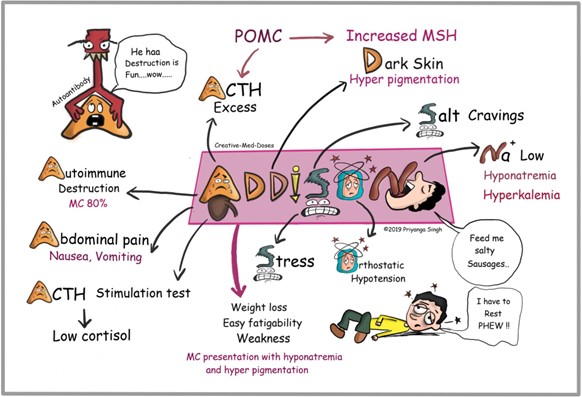The practical nurse (PN) reports that a client who has a fingerstick glucose of 35 mg/dL (1.94 mmol/L) is alert and diaphoretic. Which action should the charge nurse take?
Reference Ranges
- Glucose [Reference Range: 0 to 50 years: 74 to 106 mg/dL (4.1 to 5.9 mmol/L)]
Collect a blood sample for hemoglobin Alc.
Give the client a glass of orange juice.
Notify the healthcare provider.
Assess client for polyuria and polyphagia.
The Correct Answer is B
In this situation, the client has a fingerstick glucose level of 35 mg/dL (1.94 mmol/L) and is alert but diaphoretic. The charge nurse should take the following action:
Give the client a glass of orange juice.
A glucose level of 35 mg/dL (1.94 mmol/L) is considered significantly low (hypoglycemia), and the client's symptoms of diaphoresis indicate that the low glucose level is likely causing the symptoms. Providing the client with a glass of orange juice or another source of fast-acting carbohydrate is appropriate to quickly raise the blood sugar level and alleviate the symptoms of hypoglycemia.
Collecting a blood sample for hemoglobin A1c (HbA1c) is not necessary in this acute situation. HbA1c reflects the average blood glucose level over the past 2-3 months and is used to assess long-term glycemic control in clients with diabetes. It does not provide immediate information or guide immediate interventions for acute hypoglycemia.
Notifying the healthcare provider is not the first action to take in this situation. The client's low glucose level can be promptly addressed by administering a source of fast-acting carbohydrate, such as orange juice. If the client's symptoms persist or worsen despite appropriate intervention, or if there are other concerning factors, then notifying the healthcare provider would be appropriate.
Assessing the client for polyuria (excessive urination) and polyphagia (excessive hunger) is important in the overall management of diabetes, but it is not the immediate action to take in this acute situation of hypoglycemia. The priority at this time is to address the low blood sugar level and relieve the client's symptoms.
Nursing Test Bank
Naxlex Comprehensive Predictor Exams
Related Questions
Correct Answer is D
Explanation
The correct answer is Choice D
Choice A rationale: Splinting with a pillow may reduce discomfort during movement or coughing by stabilizing the incision site, but it does not address acute postoperative pain with sympathetic overdrive. The elevated heart rate, respiratory rate, and blood pressure suggest a stress response mediated by catecholamines. Without analgesia, nociceptive signals continue to activate the hypothalamic-pituitary-adrenal axis. While splinting is supportive, it lacks the pharmacologic efficacy needed to blunt nociceptive transmission at the spinal or supraspinal level.
Choice B rationale: Assessing IV patency is a procedural prerequisite for medication administration but not a therapeutic intervention in itself. It does not directly address the pathophysiology of acute pain or the sympathetic surge evidenced by tachycardia and hypertension. Pain activates ascending pathways via A-delta and C fibers, requiring pharmacologic blockade. IV access assessment is necessary but secondary to the urgent need for analgesia to prevent complications like hypoxia, hyperventilation, or delayed recovery.
Choice C rationale: High Fowler positioning may improve diaphragmatic excursion and reduce pulmonary complications, but it does not mitigate visceral or incisional pain. In fact, increased intra-abdominal pressure from upright posture may exacerbate pain at the surgical site. Pain perception involves central sensitization and peripheral nociceptor activation, which are unaffected by positioning. The client’s pale skin and elevated vitals indicate systemic distress requiring analgesic intervention, not postural adjustment. Thus, this choice lacks direct analgesic benefit.
Choice D rationale: IV analgesics act rapidly to inhibit nociceptive transmission at the spinal cord and brainstem levels. Opioids bind to mu receptors, reducing neurotransmitter release and hyperpolarizing neurons, thereby dampening pain signals. This intervention directly targets the physiologic cause of elevated heart rate, respiratory rate, and blood pressure. Normal heart rate is 60–100 bpm, respiratory rate 12–20 breaths/min, and BP <120/80 mmHg. Prompt analgesia prevents complications like hypoxia, delayed healing, and neuroendocrine stress
Correct Answer is C
Explanation
The client with Addison's disease is experiencing weakness, confusion, and dehydration, which can be indicative of an adrenal crisis. The low sodium level (129 mEq/L) and low glucose level (54 mg/dl) further support this suspicion. An acute viral infection can trigger an adrenal crisis in individuals with Addison's disease.

Intravenous hydrocortisone, a glucocorticoid, is the treatment of choice for managing an adrenal crisis. It helps to replenish cortisol levels and stabilize the client's condition.
Hydrocortisone helps in restoring the body's stress response and regulating electrolyte and glucose levels.
A broad-spectrum antibiotic may be necessary if there is evidence of a bacterial infection, but it does not directly address the symptoms associated with Addison's disease.
Regular insulin is used for managing high blood glucose levels in conditions such as diabetes, but in this case, the client has low glucose levels, so insulin is not the appropriate intervention.
Potassium chloride is a medication used to treat low potassium levels (hypokalemia), but the client's potassium level is within the reference range (5.3 mEq/L). Therefore, potassium chloride is not indicated in this situation.
Whether you are a student looking to ace your exams or a practicing nurse seeking to enhance your expertise , our nursing education contents will empower you with the confidence and competence to make a difference in the lives of patients and become a respected leader in the healthcare field.
Visit Naxlex, invest in your future and unlock endless possibilities with our unparalleled nursing education contents today
Report Wrong Answer on the Current Question
Do you disagree with the answer? If yes, what is your expected answer? Explain.
Kindly be descriptive with the issue you are facing.
